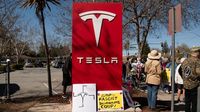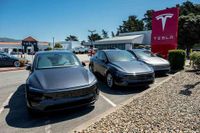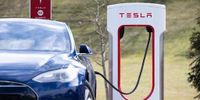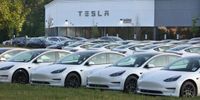Tesla gave investors a comprehensive glimpse into its financial health on April 22, 2025, during its much-anticipated earnings call, though the results were far from what Wall Street had hoped for. The electric vehicle maker reported a revenue of $19.34 billion for the first quarter, marking a 9% decline compared to the previous year and falling short of analysts' expectations of $21.43 billion. Additionally, Tesla's earnings per share plummeted 71% year over year, coming in at just $0.12 against an anticipated $0.33.
Despite these disappointing figures, Tesla's stock experienced a notable surge of over 5% in after-hours trading, largely driven by CEO Elon Musk's announcement that he would be stepping back from his role in the Department of Government Efficiency, commonly referred to as DOGE. "Starting next month, I will be allocating far more of my time to Tesla," Musk stated during the call, which seemed to reassure investors concerned about his divided attention between his corporate responsibilities and political commitments.
During the call, CFO Vaibhav Taneja addressed the decline in vehicle deliveries, attributing it to a combination of assembly line changes for the refreshed Model Y and external factors such as vandalism and a growing anti-Tesla sentiment in certain markets. "Our demand remains strong," Musk insisted, although he acknowledged that economic uncertainty often leads consumers to postpone significant purchases like cars.
As for Tesla's automotive revenue, it saw a staggering 20% drop year over year, bringing in $14 billion compared to $17.4 billion in the same quarter last year. The company also backed away from its previous forecast of returning to growth by 2025, with Musk indicating that the rate of growth would depend on various factors, including the pace of autonomy development and production ramps.
In addition to discussing financials, Tesla provided updates on its upcoming products. Musk confirmed that the company remains on track to launch its more affordable vehicle models in the first half of 2025, although he did not provide specific details on their design or pricing. "These models will resemble the form and shape of our current vehicles," Tesla stated in its earnings release.
Another key point of discussion was Tesla's planned paid robotaxi service, set to launch in Austin, Texas, with an initial fleet of 10 to 20 Model Y vehicles. This service will involve remote operators to assist vehicles in case of any issues, ensuring safety during the rollout. Musk expressed confidence in the robotaxi initiative, predicting that Tesla would have millions of fully autonomous vehicles operating by the second half of 2026.
On the topic of tariffs, Musk mentioned his advocacy for lower tariffs, stating, "I’ve made my opinion clear to the President," referring to discussions with President Trump regarding trade policies. He also noted that Tesla is likely the least affected automaker concerning tariffs due to its localized supply chain strategy, which aims to mitigate risks associated with international trade.
Amidst these announcements, Tesla's stock performance remains a point of contention. The shares have fallen approximately 41% in 2025 and are down 53% from their all-time high of $479.86 in December 2024. Analysts are increasingly concerned about the implications of Musk's political involvement on the brand, especially as protests against him have surged in both the U.S. and Europe.
Market analysts have voiced mixed sentiments regarding Tesla's future prospects. Wedbush analyst Dan Ives described the situation as a "Code Red" for Musk, urging him to refocus on Tesla and distance himself from government roles to stabilize the brand. Conversely, Deutsche Bank analysts have revised their estimates for Tesla's full-year deliveries downward, now expecting around 1.7 million vehicles, down 5% year-over-year.
Despite these challenges, Tesla's energy generation and storage revenue increased by 67% to $2.73 billion, highlighting the company's broader ambitions beyond automotive sales. The company emphasized that its energy segment is crucial for stabilizing the grid and providing additional power capacity, especially in light of increasing tariffs that could affect supply and demand.
Musk also provided updates on Tesla's humanoid robot, Optimus, stating that the company expects to have thousands of these robots operational in its factories by the end of 2025. He expressed optimism that Optimus could become Tesla's biggest product, surpassing vehicles as a revenue source.
In summary, while Tesla's first-quarter earnings report revealed significant challenges, the company's stock rallied in response to Musk's commitment to refocus on Tesla and the promising updates regarding new products and services. As the market continues to react to both the financial results and Musk's political engagements, investors remain hopeful for a turnaround in the company's fortunes.







